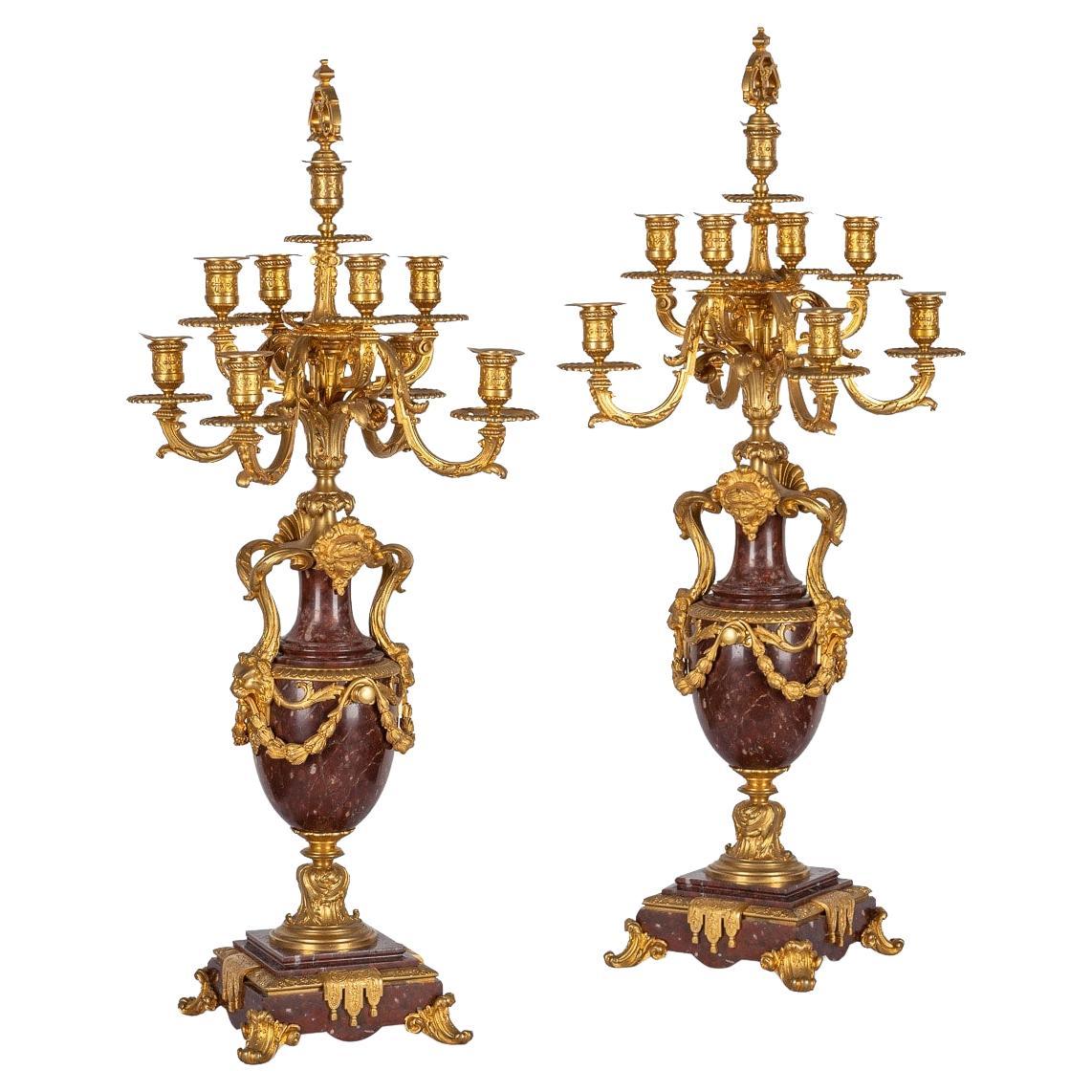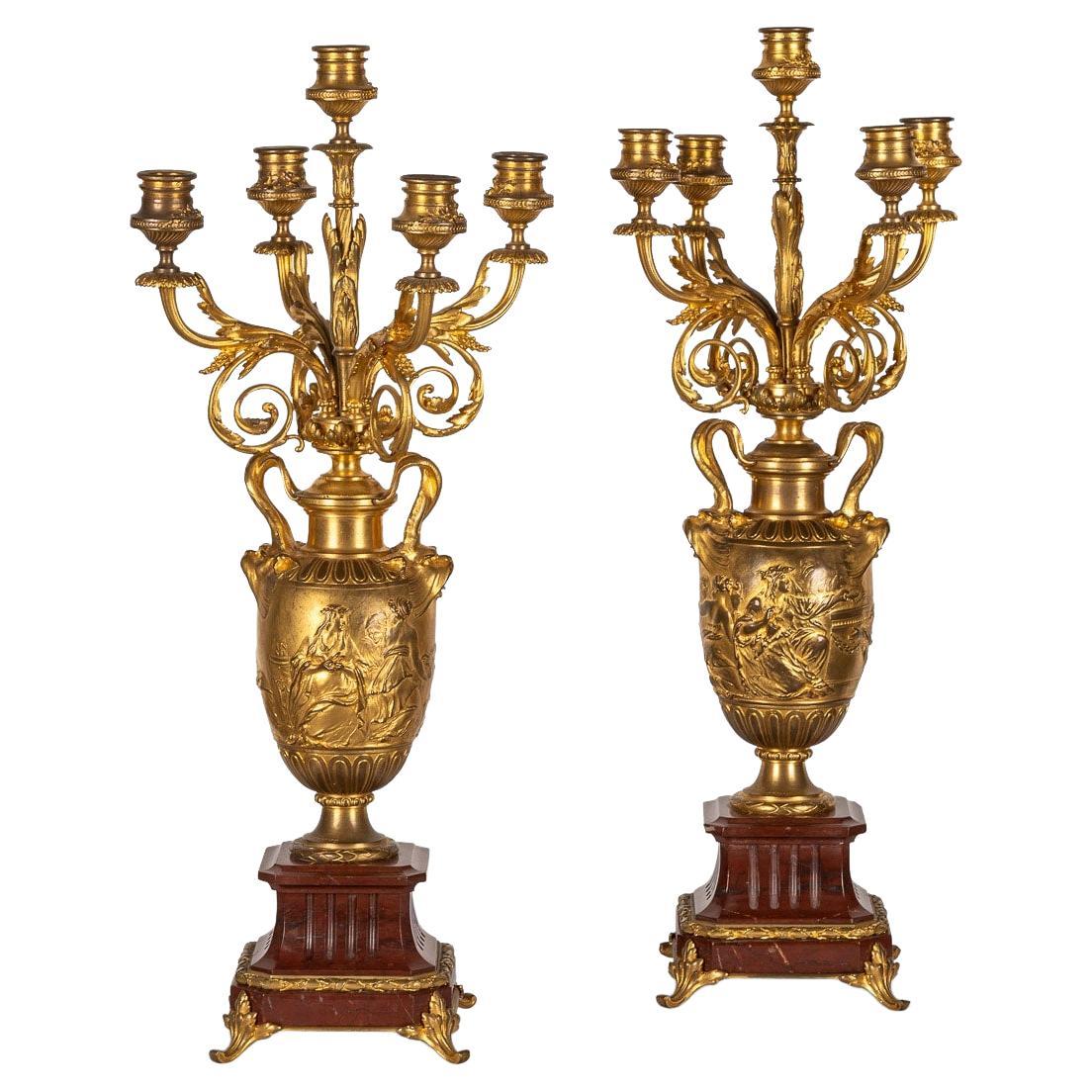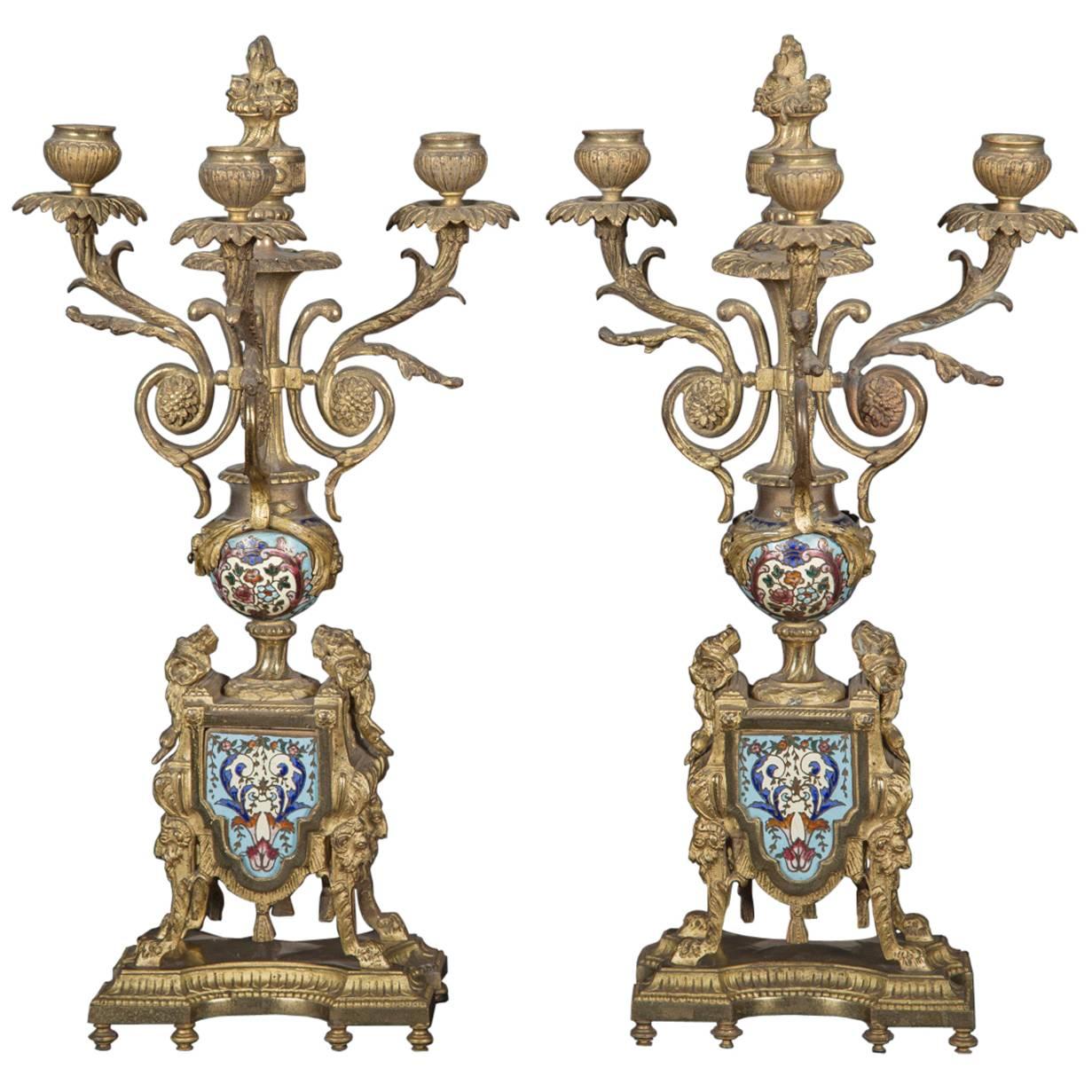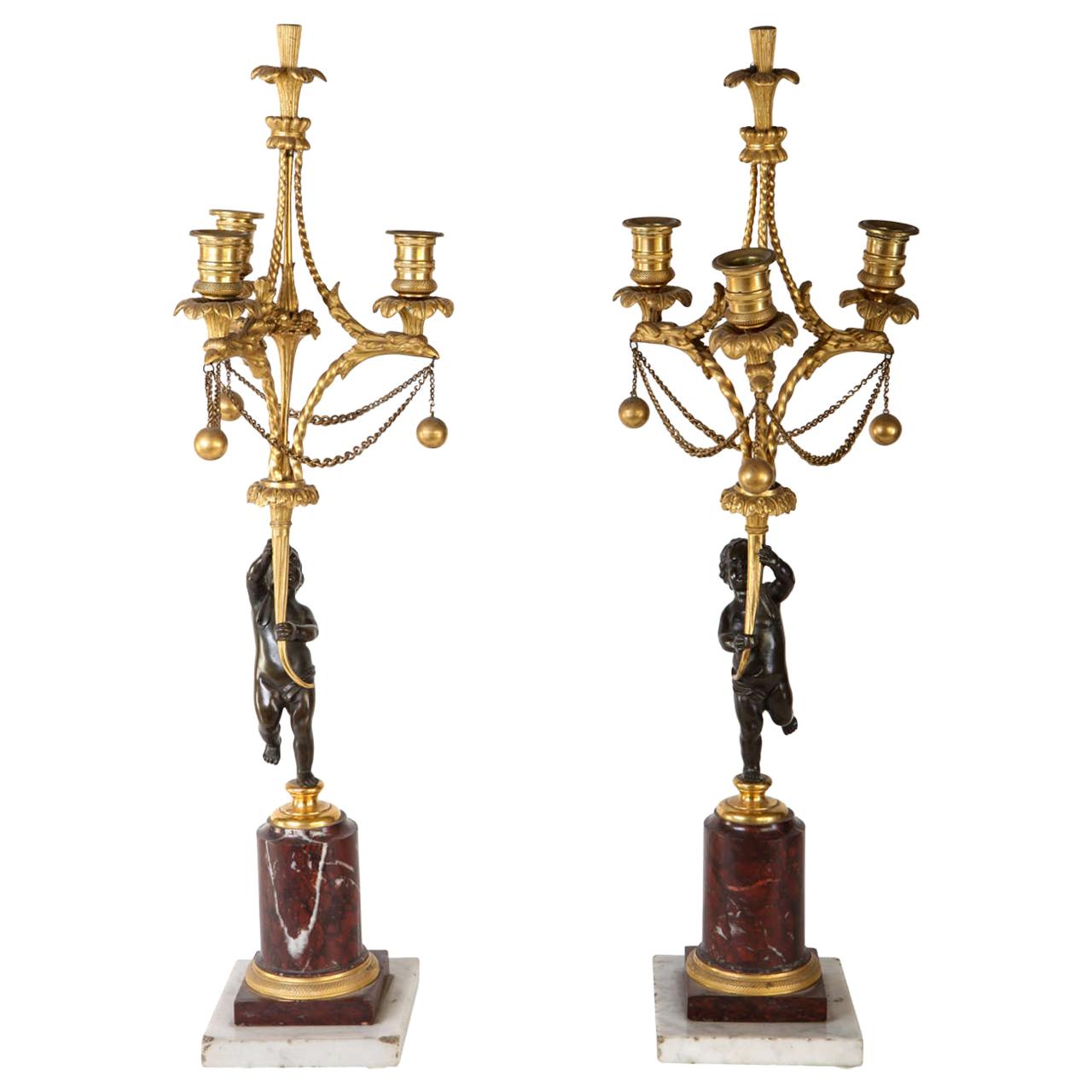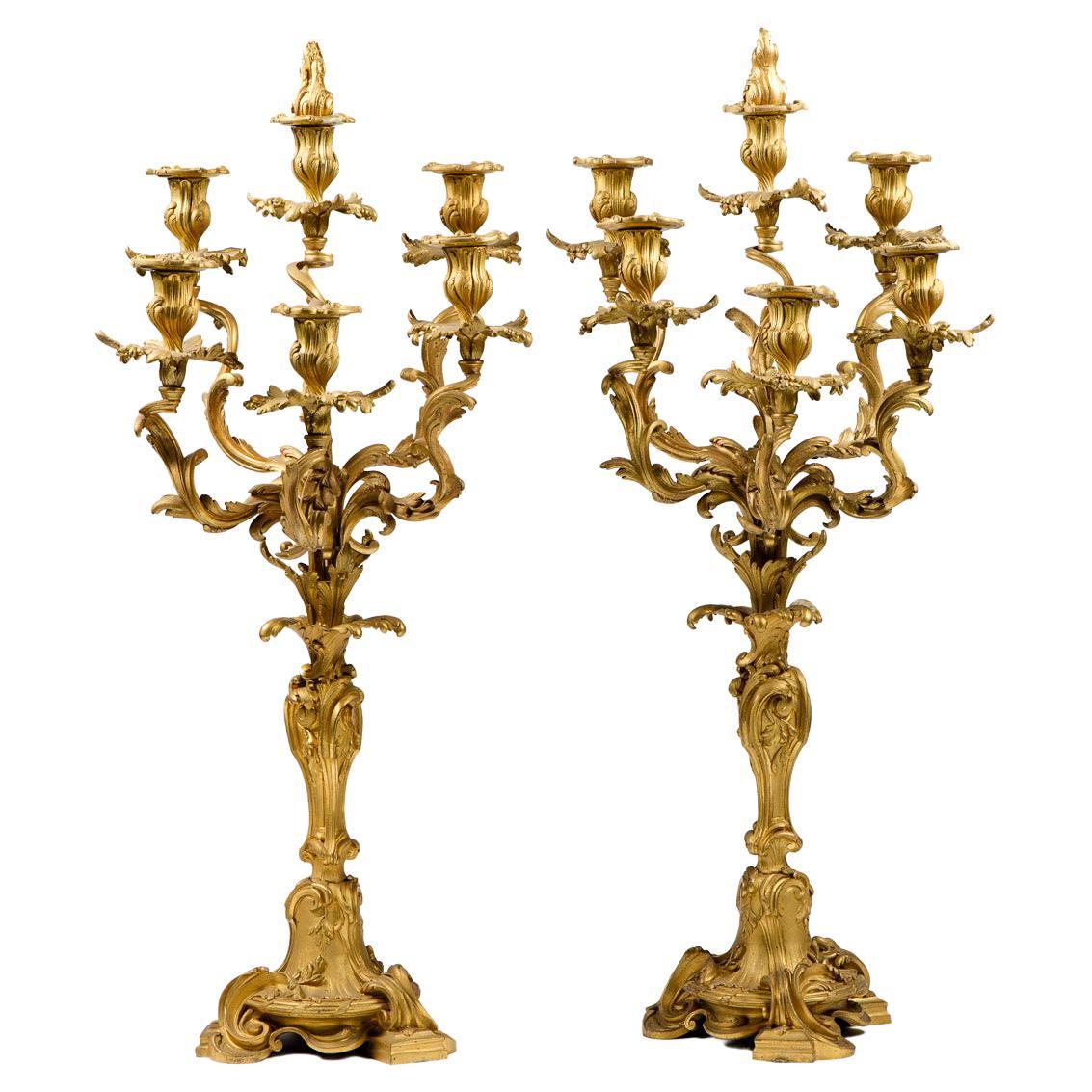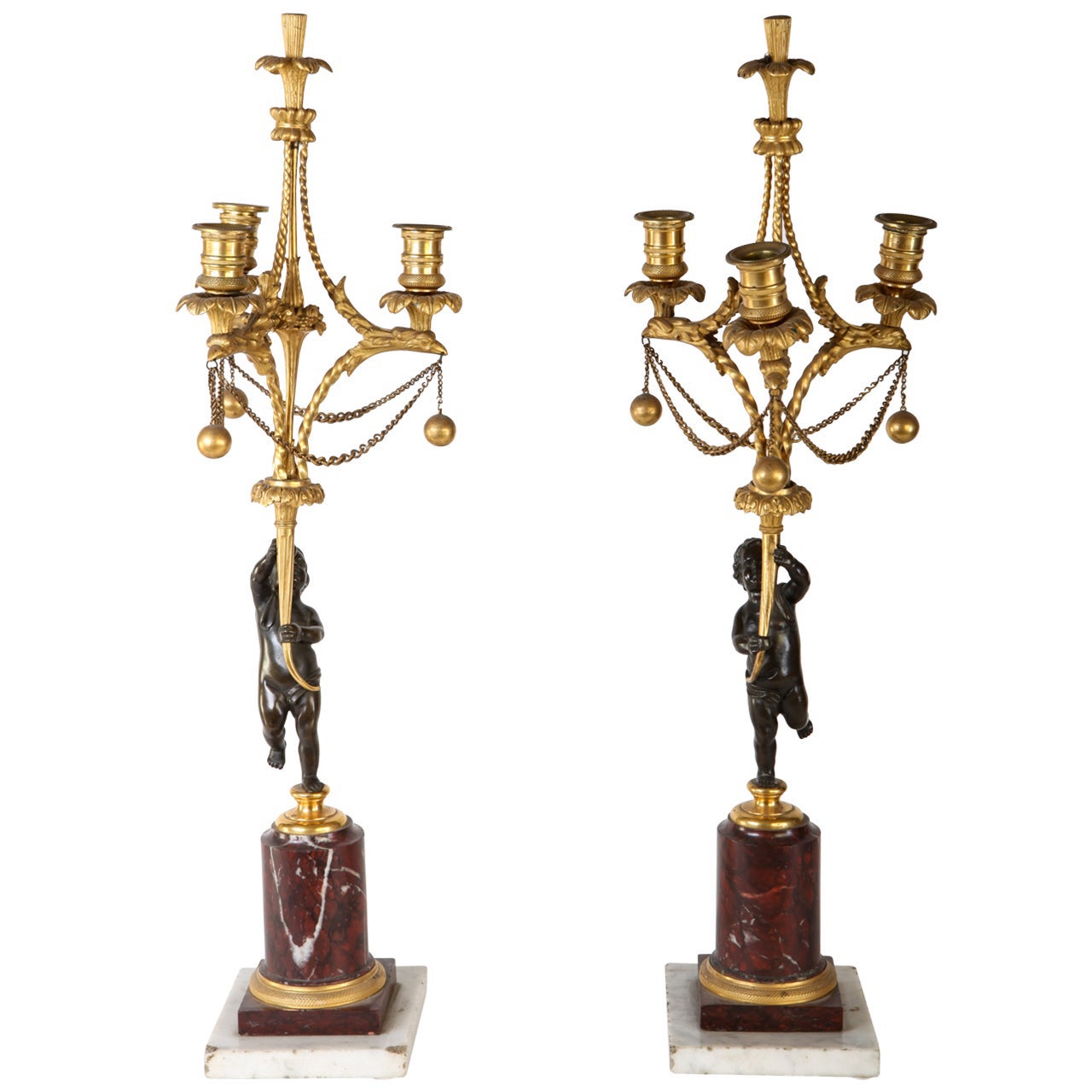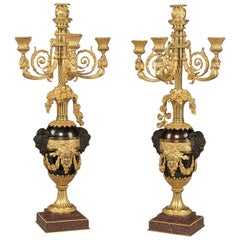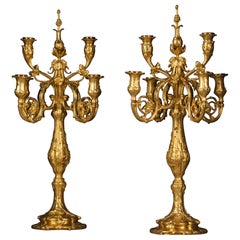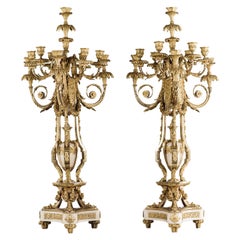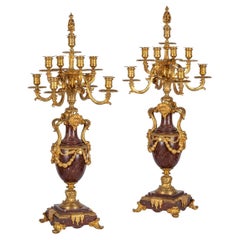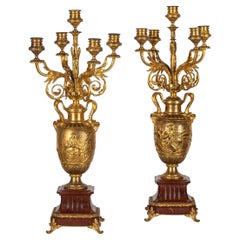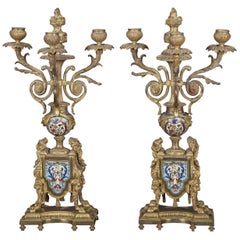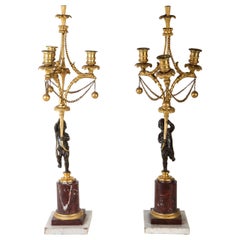Items Similar to Bronze Seven-Light Candelabra After Clodion Cast, Suse Frères French circa 1890
Want more images or videos?
Request additional images or videos from the seller
1 of 5
Bronze Seven-Light Candelabra After Clodion Cast, Suse Frères French circa 1890
$17,125.91per set
£12,500per set
€14,605.28per set
CA$23,842.50per set
A$26,080.09per set
CHF 13,635.32per set
MX$314,142.02per set
NOK 170,422.63per set
SEK 160,769.82per set
DKK 109,026.83per set
About the Item
A fine pair of gilt and patinated bronze seven-light candelabra, after a model by Clodion, Cast by Suse Frères.
Stamped 'Susse Fres'.
The candelabra are in the form of patinated bronze vases cast in a classical form after the model by Clodion, with masks depicting chimerical ibex flanked by laurel swags, above a finely carved relief of young Bacchanals at play. The vases are surmounted by acanthus collars with central stems issuing scrolling foliate cast candlearms with eagle head finials and terminating in fluted circular nozzles. Each vase is raised on a fluted circular soccle put down on a square section re-entrant red marble base with gilt-bronze foliate mounts and toupie feet.
The patinated vases, cast with a classical iconography which blends architectural elements of antiquity with the sensibility of the ‘ancien régime' are after a model by the celebrated sculptor Clodion (1738-1814), made during his time at the French Academy in Rome from 1762-1771. One noted terracotta example, formerly in the collection of the princely Russian Dolgoroukov family, is now in the Hermitage Museum, St. Petersburg (H.CK-2093), exhibited at the Clodion exhibition, musee du Louvre in 1992. A related example in marble, notably in the treatment of the masks, is in the Wallace Collection, London (S32).
Clodion's design for this pair of vases may have been influenced by a chalk drawing for a vase by François Boucher from circa 1761-1762 in which we see Bacchanalian parades and acanthus detail that is similar to Clodion's vase designs. François Boucher (1703-1770) was the leading French artist working in the Rococo style and possibly the most celebrated artist of the eighteenth century, most known for his idyllic paintings on classical themes. It is possible that this drawing served as inspiration for Clodion when designing his vases, which were executed in various versions between 1763 and 1785 and continued to be adapted well into the 19th century by later artists.
A similar design of vase appears in several of Boucher’s paintings, including Earth: Vertumnus and Pomona from 1749, now in the Columbus Museum of Art, Ohio (Reference 1980.027). Boucher had a strong impact on Clodion, who perhaps sculpted works after his drawings, supported by the fact that three paintings were included in Clodion’s personal inventory upon his death in 1814, “trois tableaux de Boucher représentant jeux d’enfants, peints sur bois, prises ensemble 3 fr”.
Susse Frères
Tracing its origins to 1758, the Paris foundry of Susse Frères is one of the oldest art foundries in Europe. They were appointed suppliers to Empress Marie Louise from 1812 and the Duc de Berry from 1818. Following the 1830 revolution they were granted a Royal Warrant as an official supplier to the monarchy. Originally a stationery company selling small bronze statuettes, the company began to focus on the process of bronze casting as early as 1839 under the direction of the brothers Michel Victor and Amedee Susse. They producing in that year a six-page catalogue of bronze sculpture.
In 1847 they obtained the right to use the Sauvage procedure for reduction, similar to that invented by Achille Collas and employed by Ferdinand Barbedienne. The ability to produce reductions of large scale bronzes enabled Susse to create editions of work in various sizes and opened up the market to collectors. Michel Victor Susse died in 1860 leaving Amedee as the sole director of the foundry until 1880 when Albert Susse became the director.
In the subsequent years Susse Frères obtained the rights to produce editions of the works of some of the most important French sculptors of the 19th century including: James Pradier, Pierre-Jules Mêne, Auguste Cain, Pierre-Nicolas Turgenev, Yevgeny Alexandrovich Lanceray, Louis-Ernest Barrias, Jules Dalou, Alexandre Falguière and Mathurin Moreau.
Renowned for the quality of its casting and multipatinated finishes, the firm of Susse Frères exhibited with notable success at many of the great exhibitions of the 19th century including a prize medal at the 1851 Great Exhibition in London and a Grand Prix at the 1905 Lieges Exposition Universelle.
Claude Michel Clodion
The son-in-law of sculptor Augustin Pajou, Clodion, (Claude Michel), (1738-1814), trained in Paris in the workshops of his uncle and Jean-Baptiste Pigalle, the most successful sculptor of the time. After winning the Prix de Rome, he moved to Italy, sharing a studio with Jean-Antoine Houdon and studying antique, Renaissance, and Baroque sculpture.
In 1771 Clodion returned to Paris, where he continued to produce mostly in terracotta. He also worked with his brothers in other media, decorating objects such as candelabra, clocks, and vases. Drawing primarily from pagan antiquity, he created light-hearted terracotta sculptures that epitomised the Rococo style. Late in his life, when neoclassical works were more popular, Clodion adjusted his style and worked on major public monuments in Paris.
French, circa 1890.
Bibliography:
“François Boucher’s Designs for Vases and Mounts.” Priore, Alicia. Studies in the Decorative Arts. Volume 3, No. 2 (Chicago, 1996). 2-51.
“Inventaire après décès de Clodion, April 13, 1814.” Reproduced in Archives de l’art français, recueil de documents inédits, nouvelle période. Volume 6 (Paris, 1912). 231.
- Creator:Susse Freres (Metalworker)
- Similar to:Claude Michel Clodion (Designer)
- Dimensions:Height: 25.6 in (65 cm)Diameter: 12.21 in (31 cm)
- Sold As:Set of 2
- Style:Louis XVI (In the Style Of)
- Materials and Techniques:
- Place of Origin:
- Period:
- Date of Manufacture:circa 1890
- Condition:Wear consistent with age and use.
- Seller Location:Brighton, GB
- Reference Number:Seller: B746001stDibs: LU1028017581472
About the Seller
5.0
Recognized Seller
These prestigious sellers are industry leaders and represent the highest echelon for item quality and design.
Established in 1964
1stDibs seller since 2014
58 sales on 1stDibs
Typical response time: <1 hour
Associations
The British Antique Dealers' AssociationLAPADA - The Association of Arts & Antiques Dealers
- ShippingRetrieving quote...Shipping from: Brighton, United Kingdom
- Return Policy
Authenticity Guarantee
In the unlikely event there’s an issue with an item’s authenticity, contact us within 1 year for a full refund. DetailsMoney-Back Guarantee
If your item is not as described, is damaged in transit, or does not arrive, contact us within 7 days for a full refund. Details24-Hour Cancellation
You have a 24-hour grace period in which to reconsider your purchase, with no questions asked.Vetted Professional Sellers
Our world-class sellers must adhere to strict standards for service and quality, maintaining the integrity of our listings.Price-Match Guarantee
If you find that a seller listed the same item for a lower price elsewhere, we’ll match it.Trusted Global Delivery
Our best-in-class carrier network provides specialized shipping options worldwide, including custom delivery.More From This Seller
View AllPair of Louis XVI Style Candelabra after François Rémond, circa 1830
By François Rémond
Located in Brighton, West Sussex
An important pair of Louis XVI style patinated and gilt-bronze four-light candelabra after the model by François Rémond, now in the Wallace collection, London.
French, circa 1830.
Stamped to one bronze ring ‘RG’.
Each candelabra has a central stem in the form of a torch en flambeau with three scrolling acanthus reeded branches terminating in sphinx heads and palm-leaf candleholders. The arms seemingly tied to the stem piece by knotted gilt-bronze cords ending in tassels. The candelabra are issued from patinated bronze ovoid vases with fluted stems and square section porphyry bases. Each vase is mounted with gilt-bronze female heads and foliate swags and encircled by a putti friezes. The handles of each vase are in the form of patinated bronze satyr’s masks.
This important pair of candelabra are after the model attributed to the ciseleur-doreur François Rémond dated 1782-5 now in the Wallace collection, London. [F.134-5]. Peter Hughes, in his catalogue entry for the Wallace candelabra...
Category
Antique Early 19th Century French Louis XVI Candelabras
Materials
Bronze
Pair of Louis XV Style Six-Light Candelabra by Robert Frères
By Robert Freres, Susse Freres
Located in Brighton, West Sussex
A Pair of Louis XV Style Gilt-Bornze Six-Light Candelabra by Robert Frères, Cast by Susse Frères.
Signed to the base ‘Robert Frères, à Paris’ and with the cachet stamp for ‘Editeur ...
Category
Antique 19th Century French Louis XV Candelabras
Materials
Bronze
Pair Of Ten-Light Candelabra After Pierre Gouthière, by Henri Picard, Circa 1870
By Henri Picard, Pierre Gouthiere
Located in Brighton, West Sussex
A Fine Pair Of Gilt-Bronze And White Marble Ten-Light Candelabra After The Model by Pierre Gouthière, by Henri Picard.
French, Circa 1870.
The gilt-bronze variously stamped 'P...
Category
Antique Late 19th Century French Louis XV Candelabras
Materials
Marble, Bronze
Pair of Patinated Bronze Nine-Light Candelabra by Barbedienne
By Ferdinand Barbedienne
Located in Brighton, West Sussex
A fine pair of neoclassical style gilt and patinated bronze nine-light candelabra by Ferdinand Barbedienne,
French, Circa 1870.
Category
Antique 19th Century French Neoclassical Revival Candelabras
Materials
Bronze
Pair of Louis XV Style Eight-Light Candelabra, Attributed to Victor Paillard
By Victor Paillard
Located in Brighton, West Sussex
A Pair of Louis XV Style Gilt-Bronze Eight-Light Candelabra, Attributed to Victor Paillard.
Each exuberantly modelled in the high rococo style with pl...
Category
Antique 19th Century French Louis XV Candelabras
Materials
Ormolu
Louis XVI Style Gilt-Bronze Four-Light Candelabrum
By Pierre Gouthiere
Located in Brighton, West Sussex
A Large and Impressive Louis XVI Style gilt-bronze four-light candelabrum, After the Model Attributed to Pierre Gouthière.
Finely cast and gilded with a central stem issuing three...
Category
Antique 19th Century French Louis XVI Candelabras
Materials
Bronze
You May Also Like
19th Century French Ormolu-Mounted Rouge Griotte Nine-Light Candelabra, c.1870
Located in Royal Tunbridge Wells, Kent
Antique 19th Century French pair of ormolu mounted on rouge griotte, nine light candelabra. Formerly with central vases, the scrolled candlearms ...
Category
Antique 19th Century French Candelabras
Materials
Griotte Marble, Ormolu
$12,708 Sale Price / set
31% Off
Free Shipping
19th Century French Pair of Candelabra by Ferdinand Barbedienne, circa 1870
By Ferdinand Barbedienne
Located in Royal Tunbridge Wells, Kent
Antique 19th century French pair of bronze and marble candelabras. These exceptional candelabras are by the renowned metalworker Ferdinand Barbedienne, made from rouge griotte marble...
Category
Antique 19th Century French Candelabras
Materials
Marble, Bronze
$12,597 / set
Free Shipping
French 19th Century Bronze and Champleve Candelabras
Located in New Orleans, LA
This unusual pair of 19th century three branch candelabra is made of bronze and features Champleve insets. The French antique pair is flat-backed, made to be used against the wall, a...
Category
Antique Late 19th Century French Candelabras
Materials
Bronze, Enamel
Fine Pair of French 18th Century Bronze and Gilt Bronze Candelabra
Located in Rome, IT
A fine pair of French 18th century bronze and gilt bronze candelabra, each in the form of putto figures holding aloft three scrolled candle-branches on a red marble and a square whit...
Category
Antique Mid-18th Century French Louis XVI Candle Holders
Materials
Bronze
$19,200 Sale Price
20% Off
Louis XV Style Pair of Candelabra Ormolu Bronze
Located in Los Angeles, CA
Whimsical pair of candelabra 6 lights and on the top you have a cabochon to extinguish the candles on this time. This is very rare to have it generally all the cabochon was lost by t...
Category
Vintage 1920s French Louis XV Candelabras
Materials
Bronze
$7,500 / item
Fine Pair of French 18th Century Bronze and Gilt Bronze Candelabra
Located in Rome, IT
A fine pair of French 18th century bronze and gilt bronze candelabra, each in the form of putto figures holding aloft three scrolled candle-branches on a red marble and a square whit...
Category
Antique Mid-18th Century French Louis XVI Candle Holders
Materials
Bronze
$19,200 Sale Price
20% Off
More Ways To Browse
1851 Great Exhibition
Clock And Candelabra
French Marble Clock And Candelabra
Clodion Bronze
Antique Fluted Vase
19th Century Life Size Bronze Sculpture
Red Marble Bronze
After Clodion
Boucher Painting
Mask Collection
Susse Freres Bronze
Bronze Susse
Eagle Finials
Alexandre Falguiere
Jean Baptiste Pigalle
Clodion Candelabra
Susse Fres
19th Century Italian Marble Clocks
